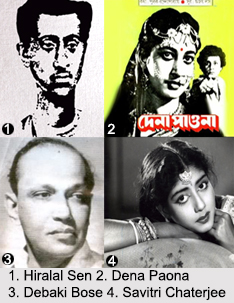 Mehboob Khan (1906-64) started working in the Silent Era as an assistant and extra in the studios of the legendary Imperial Film Company of Ardeshir Irani. From 1935 onwards he started directing films for the Sagar Film Company, before starting his own company, Mehboob Productions in 1942. Vitality, a taste for the epic, family and historical, as well as for spectacular costume drama and a tendency to film conflict in a very melodramatic way, characterizes his work. He wanted to show that Bombay (Mumbai) could do al these as well as Hollywood. The music for his films was mainly composed by Naushad.
Mehboob Khan (1906-64) started working in the Silent Era as an assistant and extra in the studios of the legendary Imperial Film Company of Ardeshir Irani. From 1935 onwards he started directing films for the Sagar Film Company, before starting his own company, Mehboob Productions in 1942. Vitality, a taste for the epic, family and historical, as well as for spectacular costume drama and a tendency to film conflict in a very melodramatic way, characterizes his work. He wanted to show that Bombay (Mumbai) could do al these as well as Hollywood. The music for his films was mainly composed by Naushad.
Out of the 24 films he made, some are marked by their admiration of Cecil B de Mille`s Bibilical films. Most of Mehboob`s films are on the list of Mumbai`s greatest successes and were even released in America and Great Britain. For Sagar Films, he made interesting films: Manmohan (1936), a social subject about a woman confronted with the patriarchal order and Jagirdar (1937), an adventure film with multiple implications. Apart from this a triangular love story was recounted in Anmol Ghadi (1946), which starred the two leading female singing stars of Hindustani cinema, Noorjehan and Suraiya. The year before, a taste for spectacular historical films, large battle scenes and flamboyant sets were all fully gratified in the film Humayun (1945). The theme of this historical film was a plea for communal harmony through the historical reconstitution of the Mughal emperor, Humayun`s reign.
One of his most innovative and well-known films are Andaz (1949). This film starred Dilip Kumar, Raj Kapoor and Nargis, the top three stars of that era. It is characteristic, and not a rare case, that in this popular melodrama, the director`s attitude to his heroine is quite conservative while at the same time he lauds the capitalist industrial development of the new India. The heroine`s easy attitude with her male friends and her modern style of dressing are considered to be reasons for her subsequent problems with these young men. Inspite of the changing times because of the influence of the West Mehboob Khan, to some extent, holds onto the ethics and values India is so famous for.
Aan was released in the year 1952 in Technicolor and was immensely successful India, London and was also dubbed in French. Shot on location against a backdrop of mountains and lakes, a massive operation involving transport of shooting equipments was undertaken. Thousands of extras and horsemen took part in the film. Animals, like lions, tiger were part of the cast of the monumental Roman-like costume drama but with Oriental shades and without defining background period. It was also the first film where Mehboob Khan introduced actress Nadira.
With its share of dances and songs the film looked like a Rajput fairytale where the villain cruised around in a Cadillac and the cruel queen was dressed in a riding dress of Jodhpur and khaki shirt. Hand to hand combat, armies in battle, treachery and penance and an overthrown princess are at the essence of this surprising film. It was fully shot in Technicolor with an enormous budget.
 As a director
As a director
* Son of India (1962)
* A Handful of Grain (1959)
* Mother India (1957)
* Amar (1954)
* Aan (1952)
* Andaz (1949)
* Anokhi Ada (1948)
* Elan (1947)
* Anmol Ghadi (1946)
* Humayun (1945)
* Najma (1943)
* Taqdeer (1943)
* Huma Gun Anmogaldi (1942)
* Roti (1942)
* Bahen (1941)
* Alibaba (1940)
* Aurat (1940)
* Ek Hi Raasta (1939)
* Hum Tum Aur Woh (1938)
* Watan (1938)
* Jagirdar (1937)
* Deccan Queen (1936)
* Manmohan (1936)
* Judgement of Allah (1935)
As a Producer
* Mother India (1957)
* Amar (1954)
* Aan (1952)
* Anokhi Ada (1948)
* Anmol Ghadi (1946)
* Zarina (1932)
As an Actor
* Zarina (1932)
* Dilawar (1931)
* Meri Jaan (1931)
As a Writer
* Watan (1938) (story)
* Judgement of Allah (1935) (story, screenplay)




















